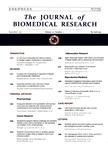Antioxidant mediated response of Scoparia dulcis in noise-induced redox imbalance and immunohistochemical changes in rat brain
Antioxidant mediated response of Scoparia dulcis in noise-induced redox imbalance and immunohistochemical changes in rat brain作者机构:Department of Physiology Dr. ALM PG Institute of Basic Medical Sciences University of Madras Taramani CampusChennai 600 113 India.
出 版 物:《The Journal of Biomedical Research》 (生物医学研究杂志(英文版))
年 卷 期:2017年第31卷第2期
页 面:143-153页
核心收录:
学科分类:1004[医学-公共卫生与预防医学(可授医学、理学学位)] 100402[医学-劳动卫生与环境卫生学] 10[医学]
基 金:provided by the University Grants Commission-RGNF(SC/ST)
主 题:free radicals oxidative stress S. dulcis nitric oxide synthase nitric oxide hydrogen peroxide
摘 要:Noise has been regarded as an environmental/occupational stressor that causes damages to both auditory and non- auditory organs. Prolonged exposure to these mediators of stress has often resulted in detrimental effect, where oxidative/nitrosative stress plays a major role. Hence, it would be appropriate to examine the possible role of free radicals in brain discrete regions and the "antioxidants" mediated response of S. dulcis. Animals were subjected to noise stress for 15 days (100 dB/4 hours/day) and estimation of endogenous free radical and antioxidant activity were carried out on brain discrete regions (the cerebral cortex, cerebellum, brainstem, striatum, hippocampus and hypothalamus). The result showed that exposure to noise could alleviate endogenous free radical generation and altered anfioxidant status in brain discrete regions when compared to that of the control groups. This alleviated free radical generation (H202 and NO) is well supported by an upregulated protein expression on immunohistochemistry of both iNOS and nNOS in the cerebral cortex on exposure to noise stress. These findings suggest that increased free radical generation and altered anti-oxidative status can cause redox imbalance in the brain discrete regions~ However, free radical scavenging activity of the plant was evident as the noise exposed group treated with S. dulcis[200 mg/(kg · b. w)] displayed a therapeutic effect by decreasing the free radical level and regulate the anti-oxidative status to that of control animals. Hence, it can be concluded that the efficacy of S. dulcis could be attributed to its free radical scavenging activity and anti-oxidative property.



